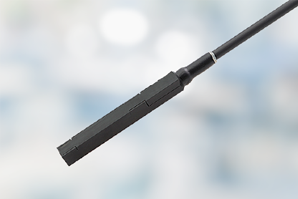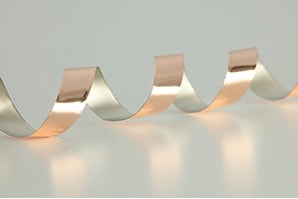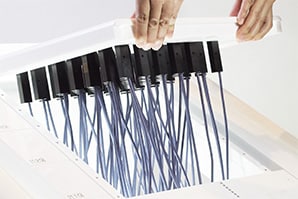New Ag-Stacked Transparent Conductive Film
A Functional Film that Contributes to
the Conservation and Creation of Energy
TDK has developed a new Ag-Stacked film, on which a thin transparent conductive Ag alloy layer is deposited on a film substrate. It has achieved lower resistance and excellent flexibility, while maintaining high transmittance equivalent to that of ITO films. It is a new-type transparent conductive film, which is suitable for applications such as light control windows (smart windows) and OPV (Organic Photovoltaics), which can contribute to the conservation and creation of energy, as well as for flexible displays and lighting or transparent electrodes of wearable devices.
Features of TDK Ag-stacked Film
- Transparent conductive film on which a thin Ag alloy layer and original protective layer are stacked
- Realizes lower resistance and excellent flexibility, while maintaining transparency equivalent to that of ITO films
- Excellent water vapor and gas barrier properties achieved by high smoothness and the continuous layer structure with in-plane uniformity
- High reflectivity in infrared region that realizes high heat shielding
- Customizable in spectral properties by nano-order thickness control
CONTENTS
Technical Background
Research and development has accelerated for the commercialization of an alternative to ITO films
There has been an increasing demand for functional films, which combine a film substrate with various features. In particular, transparent conductive films that have conductivity while being transparent are heavily used as essential elements for touch panels of smartphones or tablets or transparent electrodes of solar cells or other products.
Two characteristics are required of a transparent conductive film: transparency and high conductivity. However, transparency and conductivity are in a trade-off relationship and are difficult to achieve simultaneously, as can be seen from the fact that transparent materials are generally insulators, such as glass or plastic.
Traditionally, ITO (indium tin oxide), indium oxide doped with 10% (mass) tin, has been the mainstream transparent electrode material. ITO films feature transmittance in the visible light region and relatively high conductivity. However, there is a dilemma that, when the film thickness is reduced to increase transmittance, the surface resistivity (sheet resistance) increases and conductivity deteriorates. When an ITO film is applied to a touch panel, for instance, it is difficult to reduce the surface resistivity to 100Ω/sq. or less, as transmittance of around 90% is required. In addition, indium, which is the main material of ITO films, is a rare metal that is unevenly distributed, and therefore is faced with a risk in terms of stable supply, as well as the issue of soaring prices. As the demand for transparent conductive films increases, transparent electrode materials alternatives to ITO and active research and development for commercialization of such materials are being conducted.
Types of Transparent Conductive Films
TDK's solution using thin Ag film
Alternative ITO films include oxide-based films that do not use rare metals (zinc oxide, etc.), conductive polymer-based films, and films using new materials such as graphene or carbon nanotubes (CNT). There is also a type that uses the conductivity of the metal itself.
As a solution for overcoming limits of ITO films, TDK has focused on Ag (silver), which features the highest conductivity among metals. As the method for using Ag, there are transparent conductive films in which a metal mesh which thin Ag wires arranged in matrix is formed on a substrate, and needle-shaped Ag wires mixed in ink, which are applied and printed on a substrate. However, TDK's Ag-stacked film features a uniform thin Ag layer deposited on the film substrate surface.
Free electrons realize high conductivity in metals, and free electrons prevent light from entering inside and reflect it on the surface. Ag films that have a thickness of about 100nm or greater have high light reflectivity and are therefore used for luxury mirrors or reflection electrodes of LCDs; however, when their thickness is reduced to 20 to 30nm or smaller, transmission of visible light increases, enabling them to be used as transparent conductive films that simultaneously realize high conductivity and high transmittance. TDK's Ag-stacked film has been developed taking advantage of this.
Features and Superiority of TDK Ag-Stacked Film
Lower resistance to 1/10 or less while maintaining transmittance equivalent to that of ITO films
The film structure of TDK Ag-stacked film is shown in Figure 1. When the thickness of a thin Ag film is reduced to 20 nm or less, it becomes unstable due to the effects of oxygen, water vapor or heat, and deteriorates in optical or electrical characteristics if no measures are taken. Therefore, TDK has adopted an Ag-alloy material and its original protective material with high transmittance, and formed a transparent conductive film that has a multilayer structure of "protective-layer/Ag-alloy layer/protective-layer" on a film substrate, using an advanced sputtering method. It features continuous layer with an in-plane uniformity structure, unlike conductive films with a concave-convex surface, such as films using metal meshes or an Ag wire ink method.
In addition, the film has also realized a reduction in resistance down to 1/10 or less than that of ITO films used for touch panels (touch sensors) while maintaining a high transmittance equivalent to that of ITO films, through optimal nano-order thickness control of the layer. Moreover, the film possesses high storage reliability and heat stability, as well as high durability of repeated bending through the use of a original protective material, and the continuous layer with in-plane uniformity deposited by the sputtering method makes it possible to form the high surface smoothness.
Figure 1 Film structure of TDK Ag-stacked film
The basic characteristics of the Ag-stacked film are shown in Table 1.
The A type has a surface resistance value of 12 Ω/sq. with total light transmittance of 86%, indicating that both high transmission and low resistance can be achieved.
The B type is an ultra-low resistance type with a surface resistance that is one-fourth that of the A type and even higher conductivity.
The film surface has a very smooth and continuous film structure, and as a result both types have low haze values (cloudiness) and extremely high transparency.
No heat treatment is necessary to increase crystallinity before using the products.
| Type A | Type B | ||
|---|---|---|---|
| Surface resistance value | [ Ω/sq. ] | 12 | 4 |
| Total light transmittance | [ % ] | 86 | 82 |
| Haze | [ % ] | 0.5 | 0.5 |
| b* | [ - ] | 4.0 | 5.0 |
| Solar reflectance | [ % ] | 20 | 30 |
| Shielding coefficient | [ - ] | 0.8 | 0.6 |
| Surface roughness: Ra | [ nm ] | < 1.0 | |
| Threshold flexure diameter | [ mm ] | φ8 | |
| Repeated flexibility (Φ 10) | [ Times ] | >10000 | |
| Work function | [ eV ] | 4.7 ~ 5.1 | |
| Water vapor permeability | [ g/m2/day ] | 1.0×10-2 | |
High transmittance in the visible light region, high reflectivity in the infrared region
Furthermore, as is shown in figure 2, the spectral profile of the Ag-stacked film exhibits high transmittance in the visible light region (approx. 380 to 780nm) while exhibiting high reflectance in the infrared region, which gives the film a high heat shielding effect. Therefore, when the film is used as electrodes of windows of buildings or windows or sunroofs of automobiles, it achieves an energy-conservation effect by cutting heat rays. It can also be used as transparent wiring or antennas.
Application Possibilities Extending to the Energy Field
Expected to be applied in the energy fields such as ZEB (Zero Energy Buildings)
TDK's Ag-stacked film can also be used for various applications that differ from conventional applications in the energy field. For example, it is expected to be applied in ZEBs (Zero Energy Buildings) or ZEHs (Zero Energy Houses), which have been attracting attention in recent years. ZEBs are buildings based on the concept of reducing annual power consumption as close as possible to zero by promoting energy-saving by reviewing building structures and materials and the active use of renewable energy such as solar power generation.
It is also being considered for the conservation of energy through the use of light control windows (smart windows) applying light control films on the windows of ZEBs (figure 3). Although windows of a building mainly perform a light collection function, they transmit not only visible light but also infrared rays, which increase the room temperature, and therefore air conditioning becomes necessary in summer. However, if window areas are reduced, more lighting will become necessary. Therefore, light control windows (smart windows) have been developed to enable control of the amount of light collection depending on the season, time, or weather. A transparent conductive film that has a light shielding property as the driving electrodes of a light control film can be used for these smart windows.
Since the Ag-stacked film has high solar radiation reflectivity, it can achieve an excellent heat shielding effect by reducing the shielding coefficient. Therefore, it enables the realization of an excellent heat shielding property, as well as high visible light transmittance and sufficiently low resistance.
figure 3 Image of light control window (smart window)
In ZEBs, power generation by windows through OPV (Organic Photovoltaics) cells is also anticipated (figure 4). OPV cells are a new type of solar battery, in which an organic thin film that becomes the power generation layer is formed on a film substrate. Although their power generation efficiency is lower than that of silicon-based solar cells, they have the advantage of being able to be produced at a low cost because organic thin film can be formed by coating method. Since OPV cells are of the flexible film type, they can be used on curved glasses in combination with transparent conductive films.
figure 4 Basic structure of OPV (Organic Photovoltaics)
TDK’s Ag-stacked film is also suitable for application in organic devices including organic electroluminescence (EL) lighting. Organic EL lighting has features that LED lighting does not have such as color rendering or the capability to accommodate curved surfaces, in addition to the advantage of creating no shadow since organic EL lighting is the surface emitting type, and its market is expected to expand in the future. In particular, in organic EL lighting using transparent film substrate, a barrier film having a high water vapor barrier property is required in order to prevent degradation due to moisture. Moreover, in order to ensure flexibility, transparent electrodes that have excellent flexibility are necessary. Equipped with features such as a superior water vapor barrier property and flexibility, TDK’s Ag-stacked film can be applied to transparent electrodes of flexible organic devices including organic EL lighting. (figure 5).
figure 5 Examples of assumed applications of Ag-stacked film
Conclusion
ITO films, which are mainly used as transparent conductive films, have limits in terms of both resources and characteristics. Therefore, new alternative materials are being sought after. TDK’s Ag-stacked film is a new product that has realized a lowering of resistance to 1/10 that of ITO films, while maintaining a high transmittance equivalent to that of ITO films. It also features storage reliability, thermal stability, and flexibility achieved through its continuous layer structure that uses a original protective material, and can be used for various applications including flexible displays, wearable devices or lighting, OPV (Organic Photovoltaics) cells, light control glasses or films, and transparent antennas and so on. TDK is also advancing the development of a product with an even lower resistance of 1 Ω/sq.
Assumed Main Applications
- Transparent electrodes
Flexible displays or wearable devices
OPV (organic photovoltaics) cells, light control glasses or films, organic EL lighting, etc. - Transparent antennas, transparent electric wave shielding materials, etc.
Inquiries, Samples, Etc.
We will quickly respond to your inquiry.
We will respond quickly to any questions or requests.
Please feel free to contact us using the contact below.
-
Solving AI Energy Problems with Neuromorphic Technology
Challenge the reduction of AI power consumption using a neuromorphic device utilizing spin memristors developing by TDK. -
Ultrasensitive magnetic sensor detecting one ten-millionth of geomagnetism
Shieldless and easy-to-use device capable of detecting extremely weak magnetic field. -
Thin-film Capacitors Designed for Integration in Circuit Boards, Thickness of 50μm or Less, Flexible and Crack Resistant
Innovations for decoupling capacitors embedded within the circuit board substrate below the LSI chip. -
New Ag-Stacked Transparent Conductive Film
A functional film that contributes to the conservation and creation of energy. -
TDK Biomagnetic Sensor: Effective Alternative to SQUID (Superconducting Quantum Interference Device)
Capable of detecting extremely weak biomagnetic signals at room temperature. The world's first ambient temperature sensor to visualize the heart's magnetic field distribution. -
Optical Components Supporting Next Generation Optical Communication / Optical Transmission System
Backgrounds and technologies that support TDK's development of optical communication components and modules
















